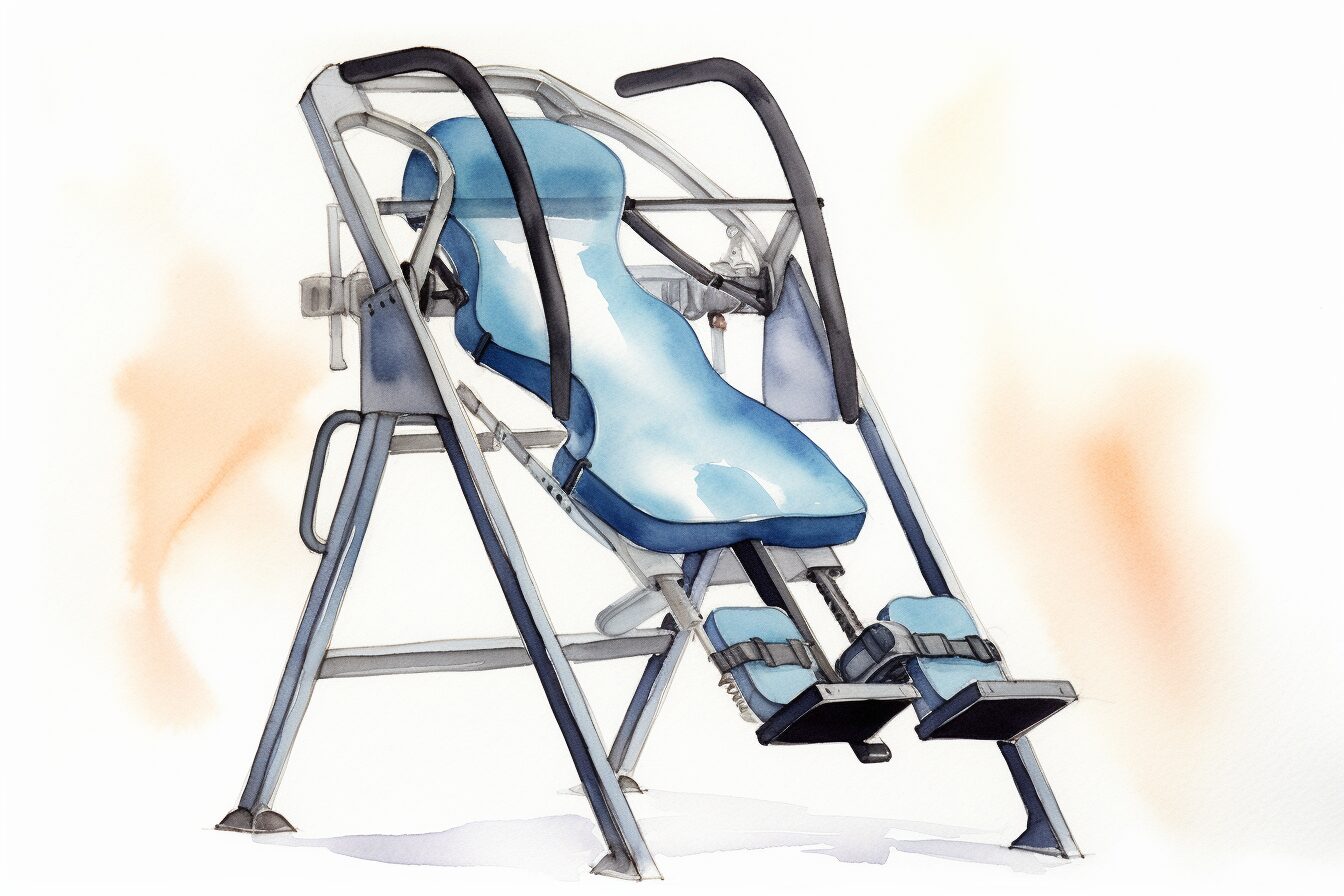Your Guide on How to Decompress Spine for Pain Relief
Let's dive straight into the heart of how to decompress spine. Exploring this path isn't merely about diminishing discomfort in your back; it's an expedition aimed at regaining your liberty to move freely and elevating your total health status. Through this read, you'll discover exercises that promise relief and techniques like the prayer stretch or kitchen sink stretch that don’t need fancy equipment. Additionally, we're diving into the world of inversion tables, showcasing them as a pivotal ally in your quest for spinal vitality. But remember, while these methods offer a path to comfort, consulting healthcare professionals is key to tailoring a safe approach suited just for you.
Table Of Contents:
- Understanding Spinal Decompression and Its Benefits
- At-Home Exercises for Spinal Decompression
- The Role of Inversion Tables in Spinal Decompression
- Addressing Spinal Disc Issues Through Decompression
- Maintaining Proper Posture for Spinal Health
- Pain Management Strategies During Decompressive Practices
- Integrating Alternative Methods Alongside Traditional Exercises
- FAQs in Relation to How to Decompress Spine
- Conclusion
Understanding Spinal Decompression and Its Benefits

Spinal decompression, a treatment not involving surgery, provides solace for individuals grappling with the discomfort of back pain. This technique aims to alleviate pressure on the spinal discs, which are gel-like cushions between the bones in your spine.
By gently stretching the spine, decompression therapy increases the space between vertebrae. This process helps promote the movement of water, oxygen, and nutrient-rich fluids into the discs so they can heal. It's like giving your spine a breath of fresh air or a long drink of water after walking through a desert.
What Conditions Benefit Most from Spinal Decompression
If you're dealing with sciatica, bulging discs, degenerative disc disease, or spinal stenosis, you might find solace in spinal decompression. Studies have shown significant results in alleviating lower back pain for these conditions.
Spinal decompression shines by pinpointing and soothing the exact spots that ache, sidestepping the need for harsh methods such as going under the knife. Imagine if you could stretch out all day long without having to do any work - that’s essentially what decompressive devices do for your spine.
Dive deeper into enhancing your well-being by discovering how Teeter's inversion tables can aid in alleviating your symptoms or introduce you to exercises that bolster the health of your lower back. These tools effectively increase space between vertebrae by using body weight as leverage against gravity during an inverted state – think hanging upside down like Batman but way safer.
In essence, consulting healthcare professionals, including chiropractors experienced in spinal care before starting any new treatment regimen ensures personalized guidance tailored specifically to meet individual needs while prioritizing safety above all else.

Subscribe To Dr Mike's MVP Newsletter!
Exclusive content, interesting topics, real insights.

At-Home Exercises for Spinal Decompression
Spinal decompression at home doesn't have to be complicated or require fancy equipment. In fact, using your body weight and a few simple exercises can bring relief from back pain by gently stretching the spine.
Starting with Low-Intensity Exercises
Gentle stretches are where you should start. Initiating your workout with the prayer stretch is brilliant for easing into it, as it gently works the lower back and avoids overburdening it. Begin on your hands and knees, sit back on your heels while reaching forward with your arms stretched out in front of you. By adopting this stance, you not only ease the burden on your spinal discs but also enhance circulation to that region.
Another great exercise is the prone pillow decompression stretch. Lie face down with a pillow under your hips; this encourages mild decompression of the lumbar region through subtle positioning.
Progressing to Moderate and High-Intensity Exercises
As you get more comfortable, move onto moderate exercises like overhead stretches which engage not only the spine but also improve shoulder flexibility—a win-win for overall posture improvement. Stand up straight, feet shoulder width apart, reach both arms above head as high as possible then slowly lean side-to-side.
The standing kitchen sink stretch involves leaning against a countertop or sturdy table edge with palms facing down—about chest height—and letting body weight gently pull downward while keeping elbows straight; an excellent way to incorporate gravitational pull into spinal elongation practices safely at home.
Key Takeaway:
Spinal decompression at home is simple and effective, starting with gentle stretches like the prayer stretch. Progress to more intense exercises as comfort increases, using just your body weight and household items. These methods are proven to ease back pain and improve posture without extra equipment.
The Role of Inversion Tables in Spinal Decompression

In the quest for back pain relief, many have turned to inversion tables as a non-invasive solution. Inverting your body with these devices leverages gravity, enabling you to dangle in reverse or at a slant. This position is known not just for its novelty but for how it effectively increases space between vertebrae.
One might wonder about the science behind inversion tables. In essence, they utilize your own weight and the force of gravity to gently stretch the spinal column. This can help alleviate compression that often contributes to discomfort and pain. It's akin to giving your spine a little 'stretch,' letting everything fall back into place.
Conditions like sciatica, bulging discs, degenerative disc disease, and spinal stenosis are notorious for causing lower back agony. Here’s where inversion therapy shines; it has shown significant results in providing much-needed relief from these ailments. But remember—while going topsy-turvy might sound like fun, starting such practices should always be under guidance or with approval from healthcare professionals.
Before hopping onto an inversion table, it's crucial to understand its proper use and potential risks alongside benefits. Consulting with healthcare providers ensures personalized advice tailored specifically towards your health condition and safety during decompression exercises.
Maintaining good posture is another critical aspect when dealing with spinal issues—something that becomes easier once regular decompression through an inversion table helps realign things ‘down there.’ So next time you think about flipping life upside-down (quite literally), consider how this tool could be part of a broader strategy towards achieving better back health.
Addressing Spinal Disc Issues Through Decompression
When you're grappling with the discomfort of disc problems like a herniated disc or degenerative disc disease, spinal decompression can be a game-changer. This gentle approach marvelously eases discomfort by lessening the burden on your spinal cushions.
Understanding Spinal Decompression and Its Benefits
The essence of spinal decompression lies in its ability to create space between the vertebrae, which reduces undue stress on spinal discs. Thus, it nurtures a healing milieu by promoting circulation and the swap of nourishments. Conditions such as sciatica, bulging discs, and spinal stenosis have shown remarkable improvement thanks to this approach.
Incorporating gentle stretches like the prayer stretch or using tools like inversion tables are among the strategies people turn to for relief at home. These methods leverage your body weight or gravity to gently pull apart the vertebrae—think of it as giving your spine a much-needed breather.
The Role of Professional Guidance
No matter how appealing DIY solutions might sound, consulting healthcare providers before diving into any form of self-decompression is crucial. Healthcare professionals are equipped to determine whether such methods align with your unique health needs, steering you towards more appropriate options when needed. Learn more about professional guidance here.
Maintaining proper posture throughout your day acts as preventative maintenance against further compressive forces that could exacerbate issues down the line—a critical yet often overlooked aspect of overall spine health.
To sum up: Whether through simple at-home exercises or sophisticated equipment like inversion tables, addressing disc issues via decompression provides not just symptomatic relief but also contributes positively toward long-term spine health when approached wisely under professional advice.
Maintaining Proper Posture for Spinal Health

Imagine your spine as the backbone of your well-being, quite literally. Standing upright isn't merely for an appearance of confidence; it's fundamentally vital in warding off the destructive pressures that can severely damage your spine's integrity. When we slouch or hunch over, our spine endures unnecessary stress, leading to potential issues down the line.
Poor posture is more than an aesthetic concern—it's a direct ticket to back pain city. The way you sit at your desk, how you stand while waiting for the bus, and even how you sleep contribute significantly to maintaining spinal integrity or deteriorating it. Adopting habits that bolster upright posture not only eases the strain on your back's discs and joints but also diminishes the likelihood of experiencing pain or harm.
Battling suboptimal posture demands not only vigilance but also a steadfast dedication to self-correction and mindfulness. Start by assessing your workstation ergonomics—ensure that screens are at eye level and chairs support lumbar curves properly. Mindfulness exercises like yoga can also encourage body awareness, teaching you to recognize when you're slipping into harmful postural habits so you can correct them promptly.
Apart from being mindful about daily activities contributing towards bad posture habits, Teeter has highlighted why engaging in specific strengthening exercises aimed at core muscles assists significantly in supporting upright positions naturally without strain throughout day-to-day life. Building strength around these areas not only boosts overall physical resilience but fortifies defenses against common triggers of back problems stemming from incorrect postural alignments.
Pain Management Strategies During Decompressive Practices
When diving into spinal decompression, whether at home or with a professional, managing pain levels is key to making the most out of your sessions. Here's how you can tackle experiencing pain and work towards chronic pain relief during these practices.
Starting Low and Going Slow
Biting off more than you can chew right from the get-go isn't just unwise; it could set back your progress by weeks. Starting with low-intensity exercises ensures that your body gets used to the new movements without overwhelming it. Gentle stretches like the prayer stretch or child’s pose not only prep your spine for more intense decompression but also keep discomfort at bay.
Increasing intensity gradually allows your body to adapt safely, reducing the risk of injury or exacerbating existing conditions.
Leverage Positional Comforts
Identifying and maintaining postures that mitigate discomfort rather than exacerbating it is essential for overall well-being. For instance, using a kitchen sink stretch provides support while allowing for controlled stretching of the spinal muscles. Similarly, bar hang-ups help in utilizing body weight naturally for decompression, letting gravity do its job in pulling apart those tightly packed spinal bones gently yet effectively.
This methodical approach not only aids in relieving pressure on nerve roots and improving blood flow but does so without causing unnecessary strain on vulnerable areas such as disc injuries or degenerative disc disease sites.
Consulting Healthcare Providers Regularly
No amount of online research beats personalized advice from healthcare professionals who understand your unique situation. Before jumping headfirst into any form of self-decompression exercise regime, consulting a trusted healthcare provider is imperative. By comprehending your distinct conditions, such as the requirements for lumbar decompression or deciding between inversion tables and conventional workouts, they're equipped to provide customized advice.
This consultation ensures that every step taken towards managing pain through decompressive practices aligns well with overall health goals and safety parameters.
Key Takeaway:
Start gently, build slowly. Use comfy positions and stretches to ease into decompression without pain. Always check in with a healthcare pro for advice tailored to you.
Integrating Alternative Methods Alongside Traditional Exercises

Finding relief from back pain often leads people down a path of traditional exercises, but what if we told you there's more to the story? Let’s explore how foam rolling can play a pivotal role in enhancing your spinal decompression efforts.
Foam Rolling: A Key Player in Spinal Health
Imagine giving your spine a massage that reaches deep into those tight spots. That's exactly what foam rolling does. It uses your body weight to apply pressure and roll out tensions, improving blood flow and flexibility. Employing this technique might just be the pivotal shift you need, far from being merely supplementary.
Beyond its immediate feel-good factor, incorporating foam rolling into your routine aids in breaking up scar tissue and reducing inflammation around the spinal discs and nerves. Incorporating it alongside stretches such as the prayer stretch or soft movements like child's pose turns it into a superb ally.
Diving Deeper with Foam Rolling Techniques
To get started, try positioning the roller under your lower back, keeping your knees bent and feet flat on the ground. Slowly roll forward until the roller reaches just below your shoulder blades then slowly return. Breathing deeply through this process enhances its effectiveness by ensuring oxygen-rich blood circulates throughout these critical areas.
The beauty of integrating alternative methods like foam rolling is that they don’t require expensive equipment or extensive training—just commitment and consistency. Incorporating these supportive techniques alongside conventional workouts adds a valuable dimension to spinal care, steering clear of invasive procedures like decompression surgery for those seeking a more holistic approach.
FAQs in Relation to How to Decompress Spine
How can I decompress my spine naturally?
Lie flat, pull your knees to your chest gently. Or hang from a bar for 30 seconds. Both stretch the back.
Is it OK to decompress your spine?
Yes, when done correctly and carefully, spinal decompression can relieve pain and improve flexibility without harm.
How to decompress your back in 30 seconds?
Grip a sturdy overhead bar. Let gravity pull you down, stretching your spine as you dangle freely. Breathe deeply.
Does stretching decompress the spine?
Absolutely. Stretching exercises that elongate the spine create space between vertebrae, reducing pressure on discs effectively.
Conclusion
So, we've journeyed through the ways on how to decompress spine. Key takeaways? Start with gentle exercises like the prayer stretch or kitchen sink stretch that don't need much but your will to improve.
Then there are inversion tables. These aren't mere tools; they stand as your partners in fostering room amidst those spinal bones, paving the way to enhanced wellness.
But remember, talking to healthcare professionals is crucial before diving into any new routine. They'll make sure what you do is safe and right for you.
Maintaining good posture throughout it all can't be overlooked either—it’s essential in keeping those compressive forces at bay.
Last but not least, integrate alternative methods like foam rolling alongside traditional exercises for that extra edge in relief and recovery.
18600 Main St STE 110, Huntington Beach, CA 92648

Subscribe To Dr Mike's MVP Newsletter.
Get In Touch
(714) 794-2171
Office Hours
Monday-Thursday:
7:00 am - 11:00 am, 2:00 pm - 6:00 pm
Friday: Closed
Saturday: By Appointment Only
Sunday: Closed

(714) 794-2171
Subscribe To Dr Mike's MVP Newsletter.
Office Hours
Monday-Thursday:
7:00 am - 11:00 am, 2:00 pm - 6:00 pm
Friday: Closed
Saturday: By Appointment Only
Sunday: Closed
18600 Main St STE 110, Huntington Beach, CA 92648
Huntington Beach Chiropractic | Copyright ©2025 | Website by iTech Valet
